
The MC-130P (formerly the HC-130P/N) Combat Shadow flies clandestine or low visibility, low-level missions into politically sensitive or hostile territory to provide air refueling for special operations helicopters. The MC-130P primarily flies its single- or multi-ship missions at night to reduce detection and intercept by airborne threats. Secondary mission capabilities include airdrop of small special operations teams, small bundles, and zodiac and combat rubber raiding craft; as well as night-vision goggle takeoffs and landings, tactical airborne radar approaches and in-flight refueling as a receiver.
MC-130P's were previously designated HC-130N/P. However, the "H" designation is a rescue and recovery mission code and not representative of the aircraft's special operations role. In February 1996, AFSOC's tanker fleet was redesignated MC-130P's, aligning the Combat Shadow with other M-series special operations mission aircraft.
MC-130P Combat Shadows and MC-130E Combat Talon I aircraft have similar missions, but the Combat Talon I's have more instruments designed for covert operations. Both aircraft fly infiltration/exfiltration missions - airdrop or land personnel and equipment in hostile territory. They also air refuel special operations helicopters and usually fly missions at night with aircrews using night-vision goggles. The Combat Talon I, however, has an electronic countermeasures suite and terrain-following radar that enables it to fly extremely low, counter enemy radar and penetrate deep into hostile territory.
Special operations forces improvements are being made to the MC-130P, with modifications completed in FY2000 featuring improved navigation, communications, threat detection and countermeasures systems. The fully modified Combat Shadow has a fully integrated inertial navigation and global positioning system, and night-vision goggle-compatible interior and exterior lighting. It also has a forward-looking infrared radar, missile and radar warning receivers, chaff and flare dispensers and night-vision goggle compatible heads-up display. In addition, it has satellite and data burst communications, as well as in-flight refueling capability as a receiver.
The Combat Shadow can fly in the day against a reduced threat, however, crews normally fly night, low-level, air refueling and formation operations using night-vision goggles. To enhance the probability of mission success and survivability near populated areas, crews employ tactics that include incorporating no external lighting or communications, and avoiding radar and weapons detection.
Originally ordered in 1963 and first flown in 1964, the HC-130s have served in many roles and missions. The aircraft was initially modified to conduct search and rescue missions, provide a command and control platform, refuel helicopters and carry supplemental fuel for extending range or air refueling. In the Vietnam War they were used to refuel Jolly and Super Jolly Green Giant helicopters and, as an airborne command post, to direct rescue efforts. Four aircraft were modified to deploy and control 10,000-pound remotely piloted vehicles. It was initially modified to conduct search and rescue missions, provide a command and control platform, air refuel helicopters and carry supplemental fuel for extending range or air refueling.
In 1986, the active-force HC-130 aircraft changed to a special operations mission. MC-130P's have been a part of the special operations mission since the mid-1980s. They provided critical air refueling to Army and Air Force helicopters during Operation Just Cause in Panama in 1989. They deployed to Saudi Arabia and Turkey in support of Desert Storm in 1990 to provide air refueling of special operations forces helicopters over friendly and hostile territory, as well as psychological operations and leaflet drops.
Since Desert Storm, the MC-130P has been involved in operations Northern and Southern Watch, supporting efforts to keep Iraqi aircraft out of the no-fly zones. Although MC-130P's left Southern Watch in 1993, they have returned periodically to relieve Air Combat Command rescue forces. The aircraft also took part in Operation Deny Flight in Yugoslavia in 1993, and Operations Restore Democracy and Uphold Democracy in Haiti in 1994. The MC-130P has been involved in operations Deliberate Force and Joint Endeavor in Bosnia since 1995. Additionally, the MC-130P took part in Operation Assured Response in 1996, providing air refueling for the MH-53s shuttling evacuees between Liberia and the rear staging area.
In March 1997, the MC-130P was diverted from Italy to provide combat search and rescue during the evacuation of non-combatant Americans from Albania. Also in 1997, the MC-130P provided command and control and refueling support during Operation Guardian Retrieval, the evacuation of Americans from Zaire. In July 1997, the aircraft provided aerial refueling for MH-53J's when U.S. forces prepared for possible evacuations of noncombatants from Cambodia. The aircraft also was part of Operation High Flight, the search to locate an American C-141 involved in a mid-air collision with another aircraft off the coast of Angola in September 1997.
The HC-130P King deploys worldwide to provide combat search and rescue coverage for US and allied forces. Combat search and rescue missions include flying low-level, preferably at night aided with night vision goggles, to an objective area where aerial refueling of a rescue helicopter is performed or pararescuemen are deployed. The secondary mission of the HC-130P is peacetime search and rescue. HC-130P aircraft and crews are uniquely trained and equipped for search and rescue in all types of terrain including artic, mountain, and maritime. Peacetime search and rescue missions may include searching for downed or missing aircraft, sinking or missing water vessels, or missing persons. The HC-130P can deploy parascuemen to a survivor, escort helicopter to a survivor, or airdrop survival equipment to a survivor.
Specifications | |
| Primary Function | Air refueling for special operations forces helicopters |
| Builder | Lockheed Aircraft Corp. |
| Power Plant | Four Allison T56-A-15 turboprop engines |
| Thrust | 4,910 shaft horsepower each engine |
| Length | 98 feet, 9 inches (30.09 meters) |
| Height | 38 feet, 6 inches (11.7 meters) |
| Maximum Takeoff Weight | 155,000 pounds (69,750 kilograms) |
| Wingspan | 132 feet, 7 inches (40.4 meters) |
| Speed | 289 miles per hour (464 kilometers per hour) at sea level |
| Ceiling | 33,000 feet (10,000 meters) |
| Range | Beyond 4,000 miles (3,478 nautical miles) |
| Crew | Four officers (pilot, co-pilot, primary navigator, secondary navigator), and four enlisted (flight engineer, communications systems operator and two loadmasters) |
| Unit Cost | $16.5 million (1992 dollars) |
| Date Deployed | 1986 |
| Inventory | Active force, 23; ANG, 0; Reserve, 5 |
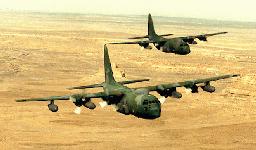
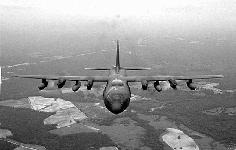
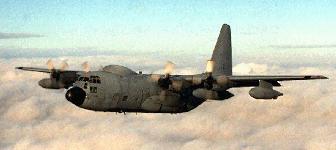

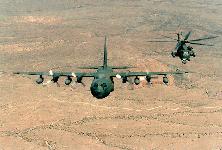

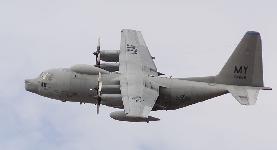







No comments:
Post a Comment